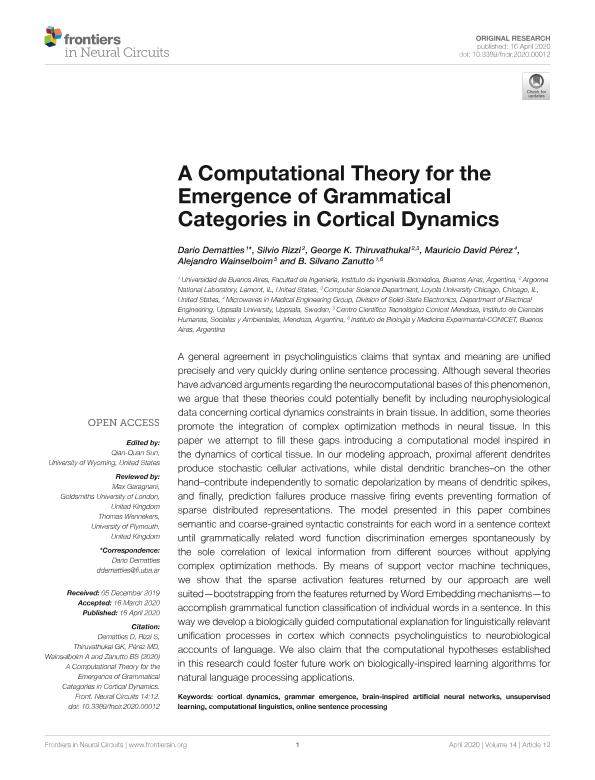Artículo
A Computational Theory for the Emergence of Grammatical Categories in Cortical Dynamics
Dematties, Dario Jesus; Rizzi, Silvio; Thiruvathukal, George K.; Pérez Cesaretti, Mauricio David; Wainselboim, Alejandro Javier ; Zanutto, Bonifacio Silvano
; Zanutto, Bonifacio Silvano
 ; Zanutto, Bonifacio Silvano
; Zanutto, Bonifacio Silvano
Fecha de publicación:
04/2020
Editorial:
Frontiers Research Foundation
Revista:
Frontiers in Neural Circuits
ISSN:
1662-5110
Idioma:
Inglés
Tipo de recurso:
Artículo publicado
Resumen
A general agreement in psycholinguistics claims that syntax and meaning are unified precisely and very quickly during online sentence processing. Although several theories have advanced arguments regarding the neurocomputational bases of this phenomenon, we argue that these theories could potentially benefit by including neurophysiological data concerning cortical dynamics constraints in brain tissue. In addition, some theories promote the integration of complex optimization methods in neural tissue. In this paper we attempt to fill these gaps introducing a computational model inspired in the dynamics of cortical tissue. In our modeling approach, proximal afferent dendrites produce stochastic cellular activations, while distal dendritic branches–on the other hand–contribute independently to somatic depolarization by means of dendritic spikes, and finally, prediction failures produce massive firing events preventing formation of sparse distributed representations. The model presented in this paper combines semantic and coarse-grained syntactic constraints for each word in a sentence context until grammatically related word function discrimination emerges spontaneously by the sole correlation of lexical information from different sources without applying complex optimization methods. By means of support vector machine techniques, we show that the sparse activation features returned by our approach are well suited—bootstrapping from the features returned by Word Embedding mechanisms—to accomplish grammatical function classification of individual words in a sentence. In this way we develop a biologically guided computational explanation for linguistically relevant unification processes in cortex which connects psycholinguistics to neurobiological accounts of language. We also claim that the computational hypotheses established in this research could foster future work on biologically-inspired learning algorithms for natural language processing applications.
Archivos asociados
Licencia
Identificadores
Colecciones
Articulos(IBYME)
Articulos de INST.DE BIOLOGIA Y MEDICINA EXPERIMENTAL (I)
Articulos de INST.DE BIOLOGIA Y MEDICINA EXPERIMENTAL (I)
Citación
Dematties, Dario Jesus; Rizzi, Silvio; Thiruvathukal, George K.; Pérez Cesaretti, Mauricio David; Wainselboim, Alejandro Javier; et al.; A Computational Theory for the Emergence of Grammatical Categories in Cortical Dynamics; Frontiers Research Foundation; Frontiers in Neural Circuits; 14; 4-2020; 1-69
Compartir
Altmétricas



